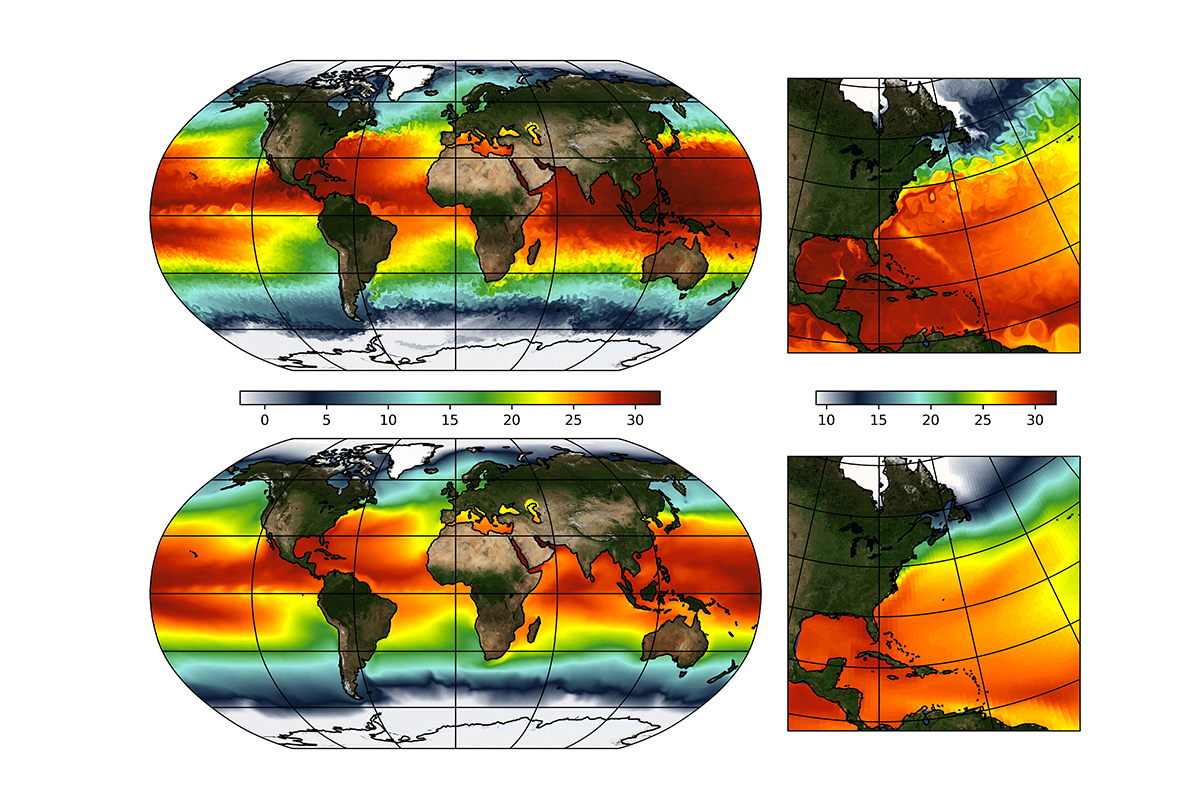Unprecedented High-Resolution Climate Simulation Developed By Texas A&M Scientist
Texas A&M University researchers and international collaborators recently published an unprecedented set of long-term, high-resolution climate simulations.
Feb 10, 2021

Sea-surface temperature field from September 21, 2018 as represented in (top) HR and (bottom) LR simulations. Right panels show a blow-up of the western North Atlantic region, with a simulated hurricane-induced cold wake visible east of the Bahamas in the HR panel (top right). Weather extremes, such as hurricanes, are not captured by LR because of the coarse model resolution. Image credit: Dr. Ping Chang.
For the first time, new high-resolution (HR) climate simulations spanning 750 years are giving scientists the ability to simulate Earth systems at such a fine resolution to clearly capture historical evidence of man-made climate change and future predictions.
Dr. Ping Chang, Professor in the Department of Oceanography at Texas A&M University, and his colleagues used a high-resolution (HR) configuration of the Community Earth System Model version 1.3 (CESM1.3) to run a 500-year pre-industrial climate simulation and a 250-year historical and future climate simulation from 1850 to 2100.
The research was recently published in the Journal of Advances in Modeling Earth Systems (JAMES) of the American Geophysical Union (AGU), and featured in the AGU’s prestigious Eos Editor’s Highlights.
Most previous and current models can only run simulations at low-resolution (LR) that resolves climate phenomena at 100 kilometers or larger. The newer HR model can simulate climate events up to 10 kilometers, ten times finer than the standard models. This new model is the first HR simulation to be run for such a long period of time.
“The challenge is to understand the impact of climate change at the regional scale, that people really care about, and that really requires a much higher resolution modeling capability,” Chang says. “Climate change is real, it’s definitely going to have an impact on regional weather patterns, and this model simulation shows very clear evidence that extreme precipitation associated with future hurricanes is going to get more intense.”
Chang was the lead author on this study and hopes future research in this area will be able to reach higher resolutions that may be able to show cloud formation in the atmosphere.
One surprising result of the HR climate simulation was the intermittent occurrence of polynyas, large openings in sea ice comparable to the size of New Zealand, in the Southern Ocean off Antarctica. Polynyas are phenomena that can last for several years as observed in the Weddell Sea during mid 1970s and are not realistically simulated by LR climate models. Chang explains that “when running at low (standard)-resolution of the same model, these phenomena simply don’t occur at all.”
The HR simulation was also in much closer agreement with historical observed data than the LR simulation in other key climate aspects such as average global surface temperatures.
This research is a first step for the International Laboratory for High-Resolution Earth System Prediction (iHESP), a collaboration between the Qingdao National Laboratory for Marine Science and Technology (QNLM), Texas A&M University, and the U.S. National Center for Atmospheric Research (NCAR).
“This collaboration can really provide the opportunity for us to understand the impacts increasing the model resolution can have on future climate projection,” Chang says.
Chang and his colleagues used the Sunway TaihuLight High Performance Computer (HPC) in Wuxi, China to run the simulations. While one of the fastest HPCs in the world, it consumes less energy than more conventional systems.
“When we make such long simulations, we actually burn a lot of electricity, so it has a significant carbon footprint,” Chang says. “So, we want to make sure that while we are trying to improve our understanding of climate change impact, we don’t increase CO2 emissions to the environment.”
Read the full journal article.
By Justin Agan ‘18
